Montag, 3. Juli 2017
Exhibition of Beijing Hutong Photography
借壁:北京胡同影像联展
借壁:北京胡同影像联展
youjia, 23:06h
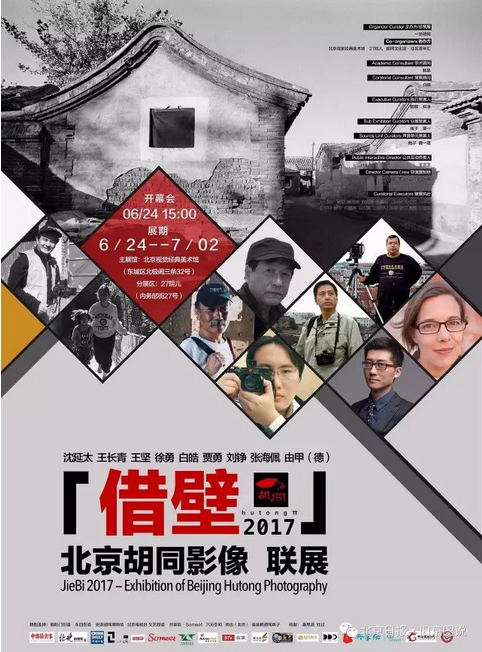
Der Titel 借壁儿, jiebir, wollte ein wunderbares Lokalkolorit sein, soll bedeuten „nebenan, beim Nachbarn“. 借, jie, heißt ausleihen und macht hier keinen Sinn, 接, jie, verbinden, erhalten, würde noch gehen, aber diese Versionen kommen alle von Nichtbeijingern, wie die Organisatoren es sind, und die wie auch ich nur Fetzen in Gassen aufschnappen. Richtig ist 隔壁儿, gebi, das erste Zeichen wird mit der Standardaussprache gé geschrieben, im Beijingdialekt aber jiè, also jiebir, ausgesprochen (von Kaijin). Aber das nur als kleine Mümmelei am Rande.
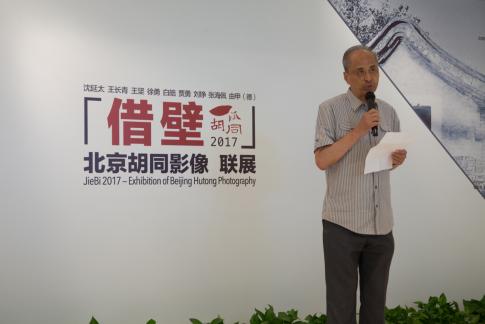
Es war mir eine Ehre, mit unter anderem Xu Yong 徐勇 und Wang Jian 王坚 ausstellen zu dürfen. Die Exhibition of Beijing Hutong Photography 借壁:北京胡同影像联展 fand statt im Beijing Museum of Visual Arts 北京视觉经典美术馆 und im wunderbar restaurierten 27 Yard 27院儿, 24.6.–2.7.2017.
Wenn auch bereits Vergangenheit, so lohnt sich ein Besuch der nicht weit voneinander entfernten Orte auch zu anderen Zeiten:
Beijing Museum of Visual Arts 北京视觉经典美术馆, Beijige santiao 32, Dongcheng District 东城区北极阁三条32号
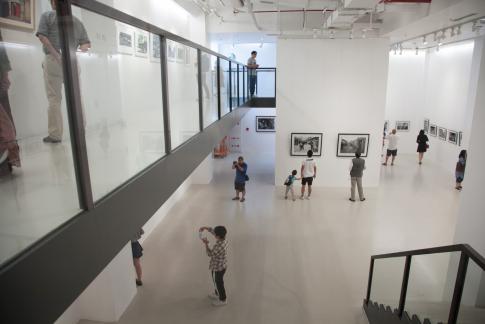
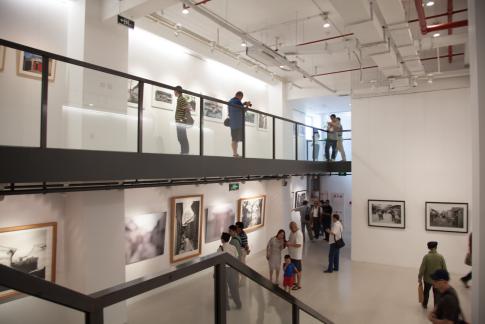
27 Yard 27院儿, Neiwubu jie 27 内务部街27号
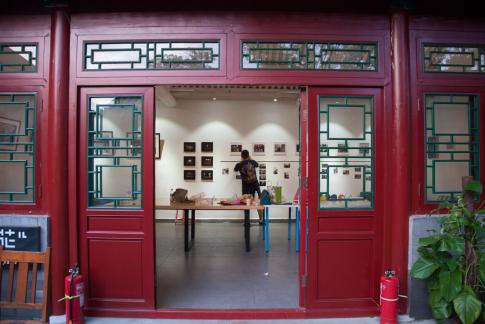
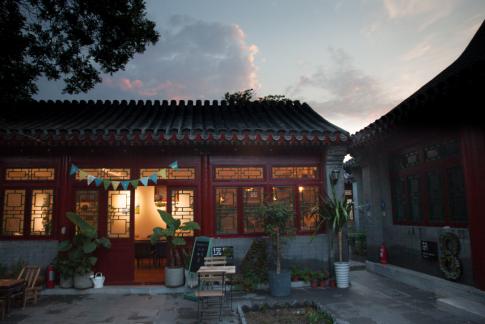
Dazu gab es einen Ausstellungskatalog, dort ein paar meiner Fotos und den folgenden kleinen Text.
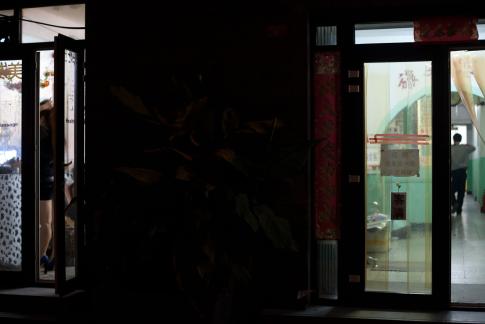
In and Out 里出外进. Hutong Shops Series 胡同小铺系列, 2014.
Hutong Shops: Open Stages at Night
Old Beijing inside the former city walls, which is now the Second Ring Road, is divided into Dong-, Xi- and Nancheng, in the Eastern, Western and Southern Districts. I have been living in Dongcheng since years and often walk through the Hutongs, especially enjoying strolls at night. I particularly like the Hutong shops, which draw one towards them like moths to the flame, it feels like they are pulling you into their ban. They appear to me as miniature stages in their own atmosphere of warm light inside the darkness of the alleys.
In photographic wanderings through the three districts, I time and again realize how different Nancheng is from the two Northern districts. Residents in the South are more proletarian and rough, the gaming places are more frequent and massage places more obviously placed next to one-hour-hotels. But also Dongcheng and Xicheng differ from each other, Dongcheng was traditionally for business, Xicheng for administration: 东富西贵南贫北贱. During Qing Dynasty, scholars and a few chosen ones with good will towards the Manchus were allowed to work and stay in the two Northern districts, whereas most Beijingers had to move to the Southern part. Nowadays, the South is still inhabited mostly by laobeijingren, while many waidiren live in the Northern spheres, overly polite within their tiny shop worlds.
It would be exaggerated to use these photo scenarios for introducing the inner districts of Beijing, but it might be a glimpse. Hopefully not completely to be turned into history, considering the present reconstructions taking place again right now.
The picture called “Wampenmann” or “Belly Guy” is named after the guy on the right side, where he is hanging out with friends in front of the store for tobacco and liquor. I photograph rather slowly, taking quite some time for compilation and adjustment. I position myself mostly in the background of a scene, but do not hide, so usually people are aware of me and sometimes a situation evolves out of it. Here, the drunkard started mumbling into my direction, asking me if I was still not ready, here, I give you something to look at, buahaha. Welcome to Nancheng.
In contrast to this stands the small family I portrayed in Dongcheng. Grandfather and father are left and right with the grandmother and the child in the middle. Initially, father and son were sitting there, when I asked if I could take a picture. They were such modest and kind people and let me have all the time I needed, until I realized that someone was waiting next to me. It was the grandmother, who did not want to disturb. I asked her to please come inside the picture, and she stepped forward, placing the child in the centre, illuminated underneath the light. Therefore, this picture is called “Holy Family”.
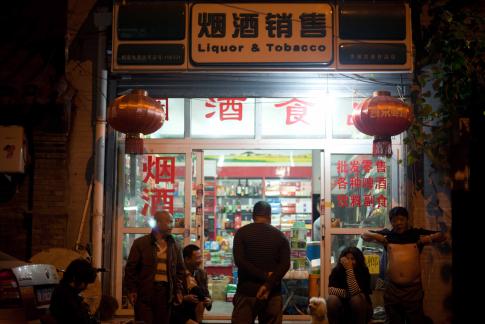
Wampenmann 大腹大哥. Hutong Shops Series 胡同小铺系列, 2014.
胡同小铺:露天舞台夜景
北京旧城墙内,即现在的二环被分为东城、西城和南城。我已经在东城生活多年,经常经过胡同,尤其喜欢夜晚在胡同里漫步。我特别喜欢胡同里的小铺,它们会让你着迷,飞蛾扑火般扑过去。在小巷黑暗中,它们如微型舞台的灯光,有着温暖的气氛。
带着相机在三个区内溜达,我一次又一次地意识南城与东城西城之间的区别。南方的居民更为无产阶级和粗犷,棋牌室较多,按摩店显然靠近一小时旅馆。而且东城和西城也不同,东城是传统的商业区,西城则是多官邸:东富西贵南贫北贱。在清代,学者和少数亲满族人是可以工作和居住在城内北部地区,而大多数人不得不搬到南部。今天,在南城居住的人大多数仍然是老北京人,而许多外地人虽然住在北半球但却仅限于他们的小店世界。
用这些照片场景来介绍北京的内环城区是有些夸张,但可能算惊鸿一瞥。考虑到目前的重建工作再次发生,希望这一瞥不会完全变成历史。
照片“大腹大哥”得名于右边那个人,摄于一家烟酒店,当时他正和他的朋友们闲逛。我拍摄得相当慢,取景和调焦颇费了些时间。我把自己定位在一个场景的背景下,但不隐藏,所以通常人们意识到我有时所拍的内容自然演变出来的。在这张照片里,这个醉鬼嘟嘟囔囔地向我走来,问我是不是还没准备好了,来,我给你看点东西看看,哈儿哈儿哈儿。欢迎来到南城。
与此相反,我在东城描述了这个小家庭。祖父和父亲是左右祖母和孩子在中间。起初,当我问我是否可以拍照时,父亲和儿子坐在那里。他们非常谦逊和善良的,让我随意拍,后来我意识到有人在我旁边等着。那是奶奶,她不想打扰我。我请她进来,她走上前去,把孩子放在中间,在灯光正下方。因此,这幅画被称为为“神圣家庭”。
翻文:曲一箴
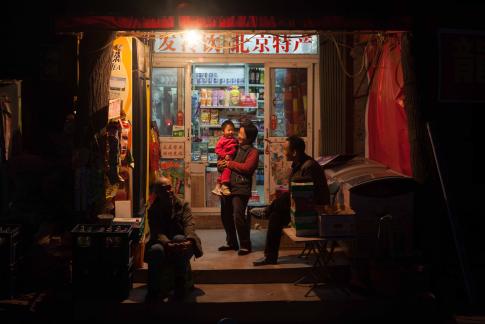
Holy Family 神圣家庭. Hutong Shops Series 胡同小铺系列, 2014.
Tags für diesen Beitrag 这本文章的标签: Ausstellung 展览, Beijing 北京, Gegenwart 当代, Fotografie 摄影, Text 文字, Häufig gelesen 频看
... comment